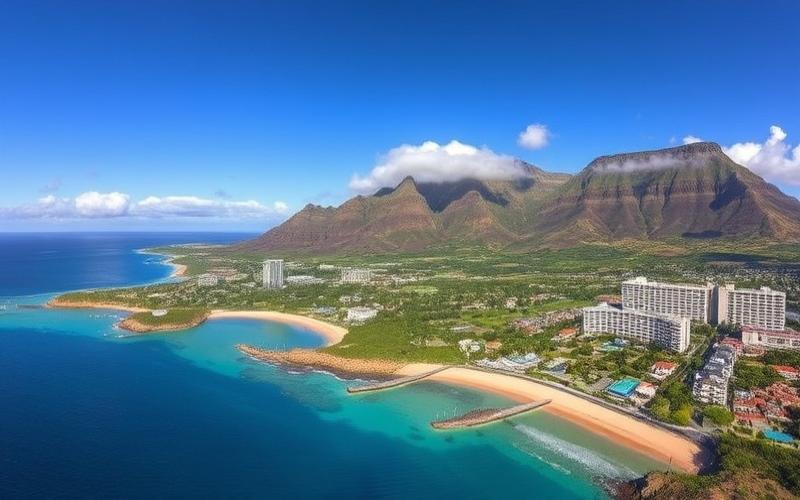
 Published on and written by Cyril Jarnias
Published on and written by Cyril Jarnias
Mauritius, the jewel of the Indian Ocean, attracts many expatriates drawn to its paradise-like living environment. If you’re considering moving there, the question of public transportation is crucial for facilitating your daily life and travel around the island. Discover in this practical guide everything you need to know about the different modes of transportation in Mauritius and the budget to plan for your travels.
From Colorful Buses to Taxis: Overview of Mauritian Transportation
The Bus Network: The Island’s Vital Artery
The bus network constitutes the backbone of public transportation in Mauritius. Managed by private companies, it serves the entire territory with regular routes connecting main towns and villages. Mauritian buses stand out with their bright colors and typical atmosphere, offering a true immersion into local culture.
The network is relatively well-developed, with high frequency on main routes. However, you need to be patient as trips can be long, especially during rush hours. Buses stop frequently to pick up or drop off passengers, which extends travel times.
Taxis: Flexibility and Comfort
For more flexibility, taxis offer an interesting alternative. They’re easily recognizable by their white color and “Taxi” sign on the roof. Rates are generally reasonable, especially for short distances. It’s recommended to negotiate the fare before departure, as taxis don’t always have meters.
Many drivers also offer day trips to discover the island’s tourist sites. This is a practical option for exploring Mauritius in a more personalized way.
Light Rail: A New Era for Mauritian Transportation
Recently, Mauritius has acquired a light rail system connecting Port Louis to Curepipe. This new modern and fast mode of transportation is revolutionizing travel along the island’s north-south axis. Although the network is still limited, extensions are planned to serve more urban areas in the coming years.
Car Rental: For Total Freedom
Although not strictly part of public transportation, car rental deserves mention. It’s a popular option among expatriates for gaining autonomy in their travels. However, be aware that driving is on the left as in England, which may require some adjustment time.
Good to Know:
Driving in Mauritius can be challenging, with roads sometimes in poor condition and limited signage. Stay vigilant, especially at night when lighting is often nonexistent.
Transportation Budget: How Much to Plan for Getting Around Mauritius?
Bus Fares: Economical but Variable
Bus fares in Mauritius are generally affordable, but they vary depending on distance traveled and the type of bus used. For a short trip in town, expect about 12 to 15 Mauritian rupees (MUR), or $0.25 to $0.30. Longer trips, for example from Port Louis to Grand Baie, can cost between 30 and 40 MUR ($0.60 to $0.80).
There’s no monthly pass per se, but some companies offer prepaid cards providing discounts on regular trips.
Taxi Costs: Negotiate Wisely
Taxi fares are higher than bus fares but remain reasonable compared to European standards. A city ride typically costs between 200 and 300 MUR ($4 to $6), while a longer trip, such as from the airport to Flic-en-Flac, can reach 1500 to 2000 MUR ($30 to $40).
Light Rail: Attractive Fares
The light rail offers attractive fares to encourage its use. A single trip costs between 20 and 30 MUR ($0.40 to $0.60) depending on distance traveled. Monthly subscriptions are also available, offering interesting discounts for regular users.
Monthly Budget for an Expatriate
For an expatriate regularly using public transportation in Mauritius, here’s an estimate of the monthly budget to plan:
- Daily bus use: 1000 to 1500 MUR ($20 to $30)
- Several taxi trips per month: 1000 to 1500 MUR ($20 to $30)
- Monthly light rail subscription (if applicable): 1000 to 1500 MUR ($20 to $30)
In total, a monthly budget of 3000 to 4500 MUR ($60 to $90) should be sufficient to cover your public transportation needs in Mauritius.
Good to Know:
These estimates may vary depending on your place of residence and travel habits. Don’t hesitate to adjust your budget after a few months on site.
Practical Tips for Using Mauritian Transportation Effectively
Plan Your Trips
Bus schedules aren’t always posted at stops. Ask locals or drivers about departure frequencies. For important trips, allow for comfortable time margins.
Prefer Small Change
On buses, it’s better to have small change to pay for your ticket. Drivers don’t always have change for large bills.
Be Aware of Rush Hours
Public transportation, especially buses, can be very crowded during rush hours. If possible, avoid these time slots or plan extra time for your travels.
Opt for Combining Transportation Modes
Don’t hesitate to combine different transportation modes to optimize your travels. For example, you can take the light rail for long distances and finish your trip by bus or taxi.
Adapting to Mauritian Pace: The Key to a Successful Experience
Using public transportation in Mauritius requires some adaptation time. The pace of life is different from that of major European cities, and you need to learn to deal with uncertainties and unexpected events. However, it’s also an excellent way to immerse yourself in local culture and experience authentic Mauritian life.
Public transportation will allow you to discover the island from an authentic perspective, interact with locals, and become familiar with the subtleties of daily life in Mauritius. With a little patience and open-mindedness, you’ll quickly find your footing and appreciate the richness of this unique transportation system.
Good to Know:
Mauritians are generally very helpful and don’t hesitate to assist expatriates with directions. Don’t be afraid to ask locals for information or advice.
In conclusion, public transportation in Mauritius offers an economical and authentic solution for daily travel. Although the system may seem confusing at first, it presents many advantages for expatriates wanting to fully immerse themselves in Mauritian life. With a reasonable budget and some adaptation, you’ll be able to fully enjoy your new life on this paradise island.
Disclaimer: The information provided on this website is for informational purposes only and does not constitute financial, legal, or professional advice. We encourage you to consult qualified experts before making any investment, real estate, or expatriation decisions. Although we strive to maintain up-to-date and accurate information, we do not guarantee the completeness, accuracy, or timeliness of the proposed content. As investment and expatriation involve risks, we disclaim any liability for potential losses or damages arising from the use of this site. Your use of this site confirms your acceptance of these terms and your understanding of the associated risks.
















